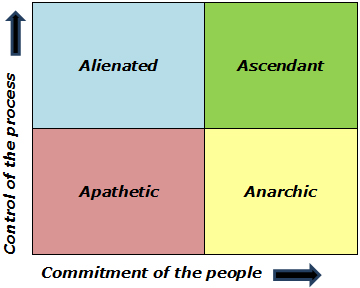The control v nurture debate has been around for some time with proponents of each view vigorously defending their respective positions. The fact that this debate continues suggests that neither position fully meets organisational needs.
In 1995 Peter Wickens produced a model which addresses this issue more fully and deserves to be better known. According to Wickens, organisations fall into one of four quadrants.

Organisations in the anarchic quadrant have high levels of individual commitment but little control. People do what they think is right for the organisation or themselves without much thought for any corporate objectives.
The alienated organisation has autocratic managers and utilises top-down imposition of rules and procedures, with little or no attempt toto to involve people or get their co-operation except by edict.
With apathetic organisations there is neither commitment nor control: no centrally respected authority nor any attempt to involve the workforce. People broadly do what they want, without any shared objectives or sense of direction.
The ascendant organisation combines high levels of commitment of its people and control of the processes to achieve a synthesis between high effectiveness and high quality of life leading to long-term, sustainable business success.
Commitment, though, does not come from the length or style of a contract. It comes from ensuring that, irrespective of their employment status, everyone is treated with respect, no one is a second class citizen, the contribution of everyone is both valued and seen to be valued and the employer helps employees develop their talents and skills.
The ascendant organisation is a holistic concept requiring high-quality controls, high-calibre, highly motivated people, and effective leadership committed to creating a culture that values these attributes.



